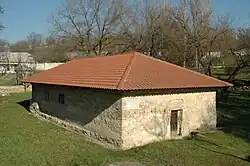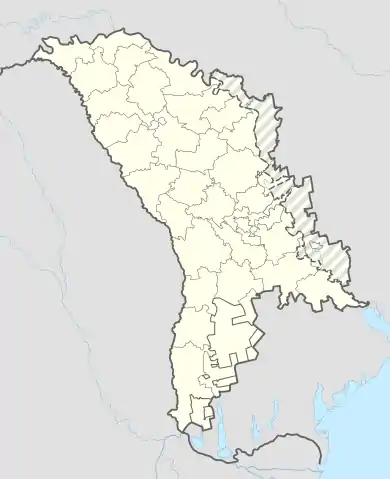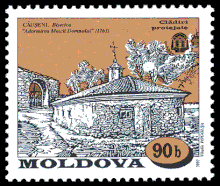Căușeni | |
|---|---|
 | |
 Flag  Coat of arms | |
 Căușeni Location within Moldova | |
| Coordinates: 46°38′N 29°24′E / 46.633°N 29.400°E | |
| Country | Moldova |
| County | Căușeni District |
| Government | |
| • Mayor | Anatolie Donțu (PPDA) |
| Elevation | 7 m (23 ft) |
| Population | |
| • Total | 15,939 |
| Time zone | UTC+2 (EET) |
| • Summer (DST) | UTC+3 (EEST) |
| Postal code | MD-4300 |
| Area code | +373 243 |
| Climate | Cfb |
| Website | primaria.causeni.org |
Căușeni (Romanian pronunciation: [kə.uˈʃenʲ]) is a town and the administrative center of Căușeni District, Moldova.
History
In the 17th and 18th centuries, Căușeni was the capital of the Budjak Horde.
The 17th century Assumption of Our Lady Church is the oldest surviving building in the town.[2] It is set more than 3 feet (0.91 m) below ground level and preserves the only medieval fresco in the Republic of Moldova. Executed by Walachian painters in a late Byzantine-Romanian style, the interiors feature religious scenes and iconography in vibrant reds, gold, and blues.
At one time it was a vibrant Jewish shtetl. In 1897, 45 percent of the population (1,675) was Jewish, most working in agriculture.[3]
Demographics
According to the 2014 census, the population of Căușeni amounted to 15,939 inhabitants, a decrease compared to the previous census in 2004, when 17,757 inhabitants were registered. Of these, 7,606 were men and 8,333 were women.[4]
Ethnic composition of Căușeni (2014)[5]
Footnotes:
* There is an ongoing controversy regarding the ethnic identification of Moldovans and Romanians.
* Moldovan language is one of the two local names for the Romanian language in Moldova. In 2013, the Constitutional Court of Moldova interpreted that Article 13 of the constitution is superseded by the Declaration of Independence,[7] thus giving official status to the name Romanian.[8][9]
| Year | Pop. | ±% |
|---|---|---|
| 1970 | 12,874 | — |
| 1979 | 17,390 | +35.1% |
| 1989 | 20,761 | +19.4% |
| 2004 | 17,757 | −14.5% |
| 2014 | 15,939 | −10.2% |
Notable people
- Bianna Golodryga, journalist at CNN
- Alexandru Pînzari, former Moldovan Chief of Police and former Moldovan Minister of Defence
Gallery
References
- ↑ Results of Population and Housing Census in the Republic of Moldova in 2014: "Characteristics - Population (population by communes, religion, citizenship)" (XLS). National Bureau of Statistics of the Republic of Moldova. 2017. Retrieved 1 May 2017.
- ↑ http://www.natura2000oltenita-chiciu.ro/wp-content/uploads/2019/05/Moldova-Pitoreasca-Picturesque-Moldavia-pdf-Vladimir-Toncea.pdf
- ↑ "Kaushany". Jewish Virtual Library. Retrieved 3 June 2017.
- ↑ "2014 Moldova Census of Population and Housing". National Bureau of Statistics of the Republic of Moldova. (in Romanian, Russian, and English)
- ↑ "2014 Moldova Census of Population and Housing". National Bureau of Statistics of the Republic of Moldova. (in Romanian, Russian, and English)
- ↑ "2014 Moldova Census of Population and Housing". National Bureau of Statistics of the Republic of Moldova. (in Romanian, Russian, and English)
- ↑ "Hotărâre Nr. 36 din 05.12.2013 privind interpretarea articolului 13 alin. (1) din Constituție în corelație cu Preambulul Constituției și Declarația de Independență a Republicii Moldova (Sesizările nr. 8b/2013 și 41b/2013)" (in Romanian). Constitutional Court of Moldova. Archived from the original on 5 March 2016. Retrieved 20 December 2013.
124. ... Prin urmare, Curtea consideră că prevederea conținută în Declarația de Independență referitoare la limba română ca limbă de stat a Republicii Moldova prevalează asupra prevederii referitoare la limba moldovenească conținute în articolul 13 al Constituției.
[124. ... Therefore, the Court considers that the provision contained in the Declaration of Independence regarding the Romanian language as the state language of the Republic of Moldova prevails over the provision regarding the Moldovan language contained in Article 13 of the Constitution.] - ↑ "Moldovan court rules official language is 'Romanian', replacing Soviet-flavored 'Moldovan'". Fox News. Associated Press. 5 December 2013. Archived from the original on 9 December 2013. Retrieved 7 December 2013.
- ↑ "Chisinau Recognizes Romanian As Official Language". Radio Free Europe/Radio Liberty. 5 December 2013. Archived from the original on 23 September 2016. Retrieved 11 March 2014.
External links

